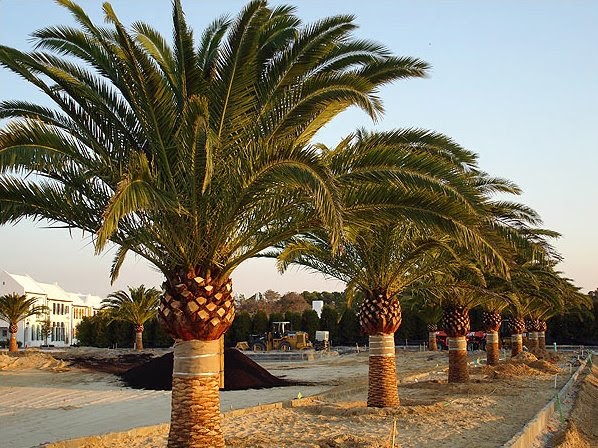A Small but Mighty Addition Growing and Caring for Small Canary Island Date Palms
The canary island date palm also known by its scientific name Phoenix canariensis is a stunning tropical palm tree that can bring a touch of paradise to any landscape. While these palms can grow up to 60 feet tall, small canary island date palms, topping out at just 8-10 feet tall, are an excellent choice for a compact, tropical look. With feathery pinnate fronds in deep green hues and a tapered, pineapple-patterned trunk, these petite palms pack plenty of visual impact. Read on to learn more about growing and caring for small canary island date palms.
Getting to Know the Canary Island Date Palm
The canary island date palm hails from the Canary Islands, an archipelago off the coast of northwest Africa. It thrives in subtropical climates and can tolerate salt, wind, drought and even cold temperatures down to 20°F. Cold hardiness makes this palm suitable for growing in USDA zones 8b through 11, though it’s most commonly grown across the southern United States, from California to Florida.
This palm grows at a moderate pace, adding just 12-24 inches of height per year. Left unpruned, canary island date palms can reach staggering heights of 60 feet or more, but regular pruning will keep them at a more manageable size. Even small canary palms will need occasional pruning to control their growth and maintain their compact shape.
Adding a Small Canary Palm to Your Landscape
Thanks to their relatively slow growth and small size, canary island date palms in the 8-10 foot range make excellent container specimens. Their height allows them to anchor taller pots without toppling, and their root balls are sized such that they won’t quickly outgrow their containers. Well-draining potting soil amended with slow-release palm fertilizer is ideal.
In the landscape, small canary island date palms command attention even without towering heights. Plant them individually as accent plants or in small groupings of three to five. Give each palm plenty of room to grow, spacing them 8-15 feet apart depending on the expected mature size. Site them in full sun for best growth and appearance.
Caring for Your Petite Palm
Small canary island date palms are just as hardy as their larger counterparts, but their compact size does have some care implications. Follow these tips to keep your mini palm looking its best:
-
Water thoroughly when the top few inches of soil become dry. Provide extra water during hot, dry periods.
-
Apply controlled-release palm fertilizer in early spring and mid-summer. Avoid over-fertilizing, which can burn roots.
-
Prune off dead fronds and old fruit stalks to keep the canopy clean and prevent pest infestations.
-
Monitor for common palm pests like scales, mealybugs and mites and treat promptly if found. Preventative systemic insecticides can help.
-
Repot container-grown palms every 2-3 years in early spring using fresh palm potting mix. Prune roots if rootbound.
-
Protect small palms from frost and freezing if growing in marginal climates. Cold winds can also damage fronds.
With the right care and conditions, a small canary island date palm will thrive for decades to come. Though petite in size, these tropical beauties will bring a sense of grandeur to gardens and landscapes across many zones. If you’re looking to add a touch of the tropics in a compact form, look no further than the mighty small canary island date palm.

Recently Shipped Canary Island Date Palm
The Canary Island Date Palm, or Pineapple Palm, is found across subtropical climates. Typically ranging in height from 30 to 60 ft. , it is a stately, proud addiction to landscaping. It’s quite hardy, and tolerant of a wide range of conditions – everything from drought to flooding. It prefers full sun and well-drained soil, but it can also tolerate deep shade.
The Pineapple Palm has a wide brown trunk that looks great with its pineapple-shaped crowns and deep green, exotic-looking fronds. This palm will be the focal point of your walkway, pool, driveway or elsewhere in your garden.
Another name for the Canary Island Date Palm is Phoenix Canariensis. It is one of the most common palms used for decoration. It was first brought to Europe in the 1600s. In the 1700s, it spread to North Africa and West Asia, among other places. It was first found in the coastal and urban areas. This plant is very hardy and a great choice for people who want to bring a plant inside.
Scientific Name: Phoenix canariensis
Overview: The Canary Island Date Palm is a marvel in the gardening world. With its slow growth and low maintenance, many people would love to have them in their homes. You can really help your Canary Island Date Palm grow and become a healthy plant by giving it some simple care.
If you want the best for your plant, you should move it outside. With its air-purifying characteristics, the palm tree is great for your home and improving air quality. Not just that, but its beautiful leaves contribute to the aesthetics of your home. But be careful, because the spines on the leaves are poisonous and can poke you.
Canary Island Date Palm 5 -7- 9 ft/The Tree Planters Installing Trees and Palms for 50 Years
FAQ
How tall does a Canary Island Date Palm get?
How do you care for a Canary Island Date Palm?
How hardy is a Canary Island Date Palm?
Will Canary Island Date Palm survive frost?
- A Complete Guide to Caring for Yuki Cherry Blossom Shrub - January 23, 2025
- Identifying Red Hot Poker Seeds: What to Look For When Harvesting Torch Lily Pods - January 23, 2025
- A Complete Guide to Harvesting Evening Primrose Seeds - January 23, 2025
